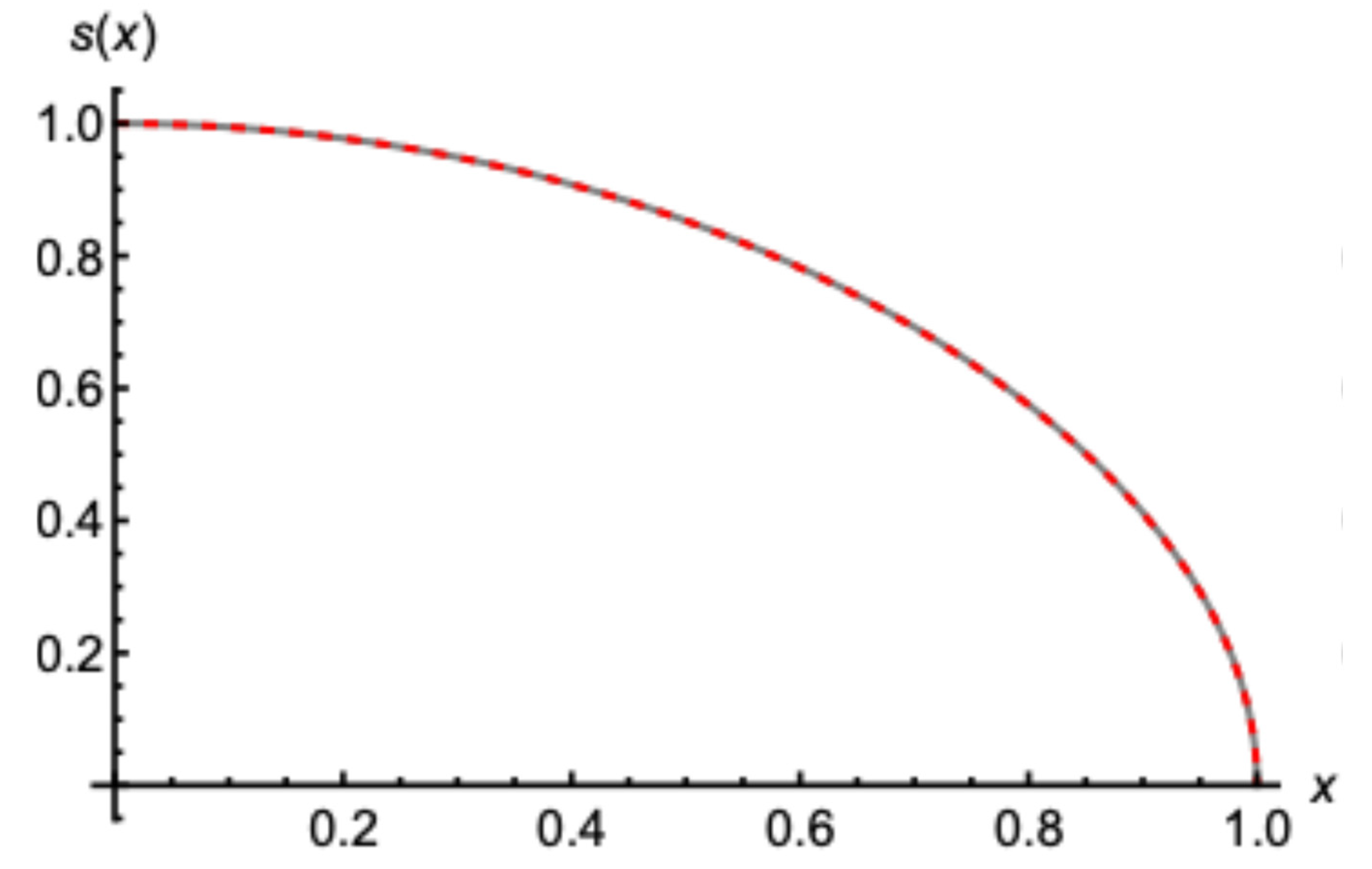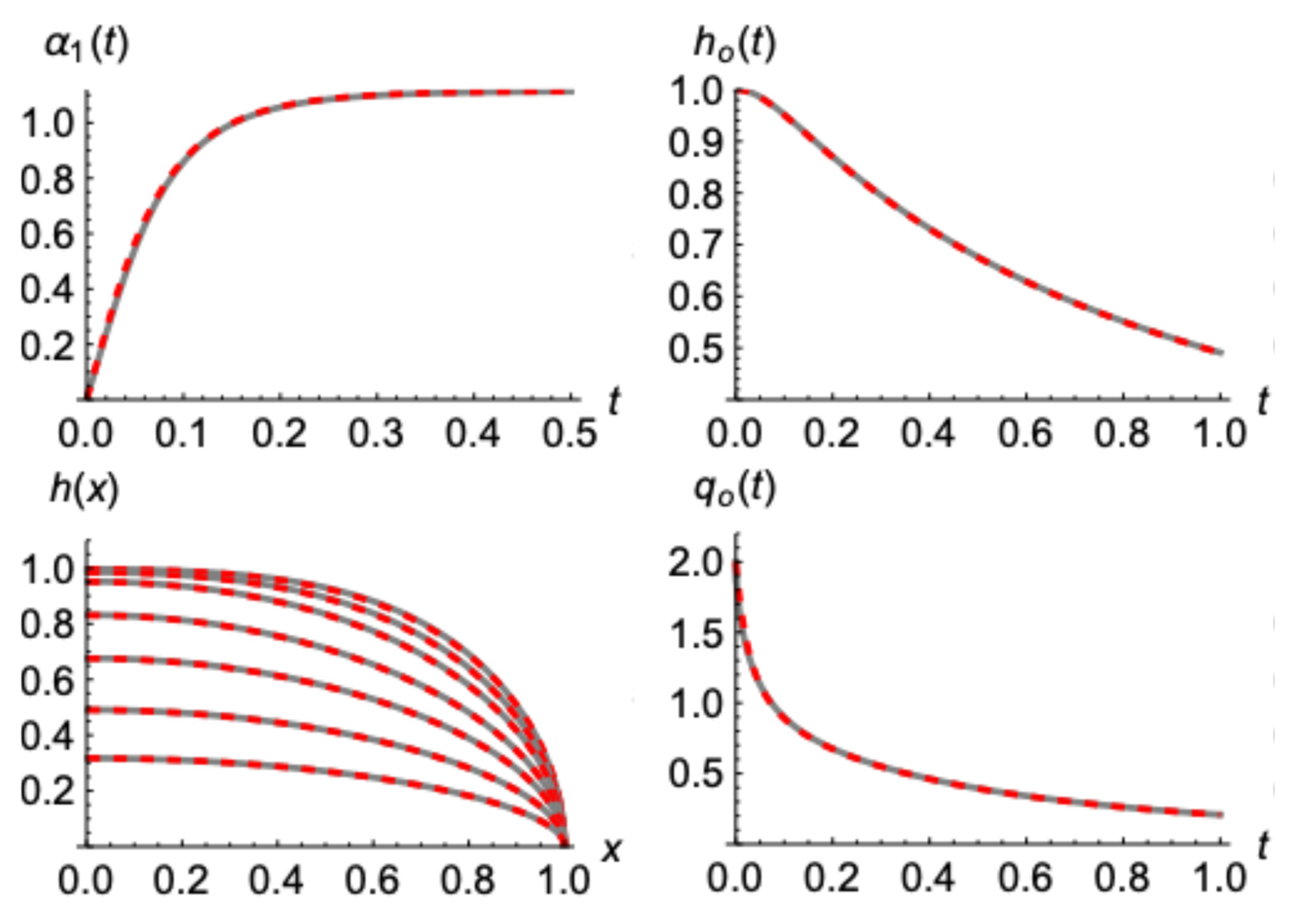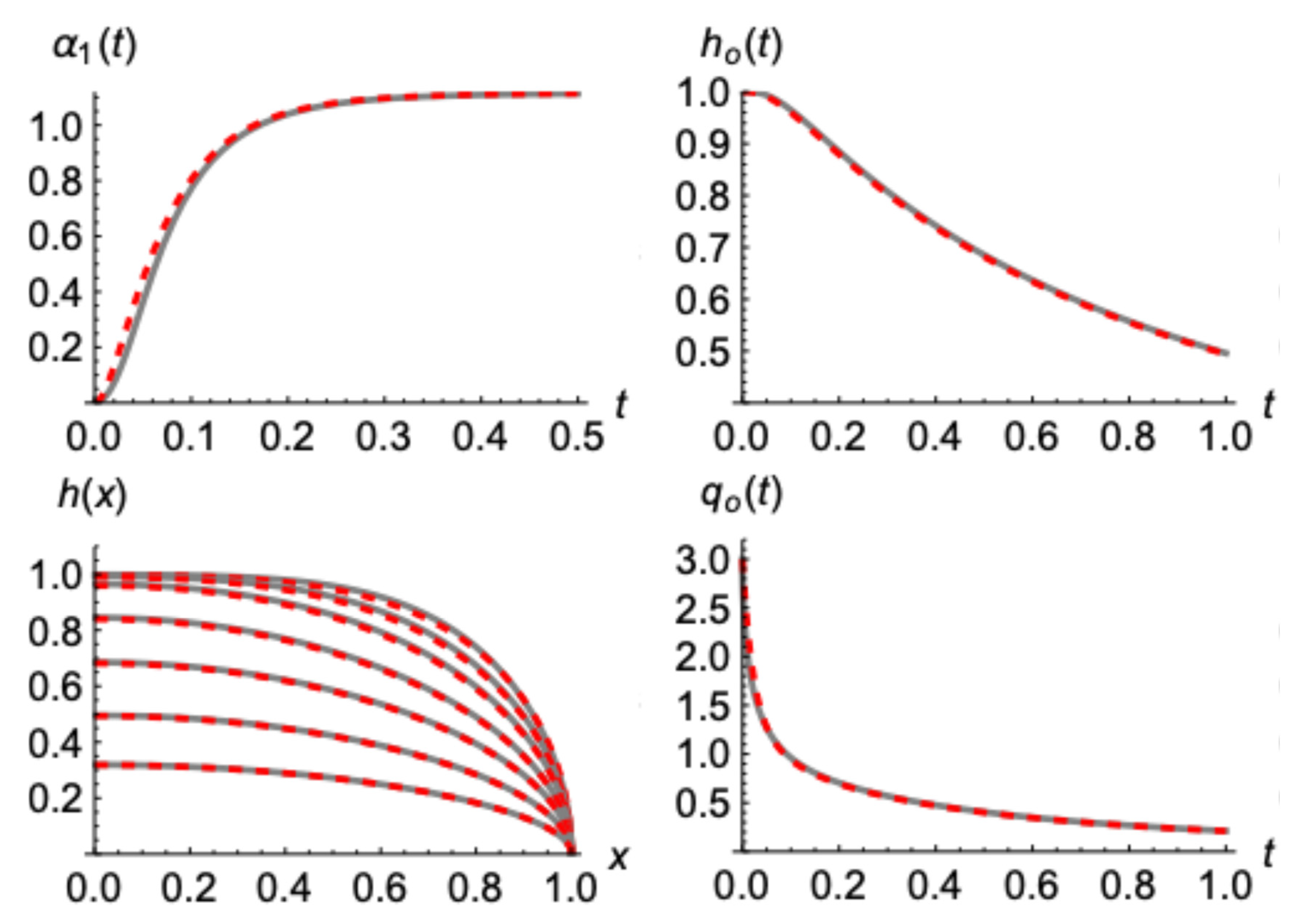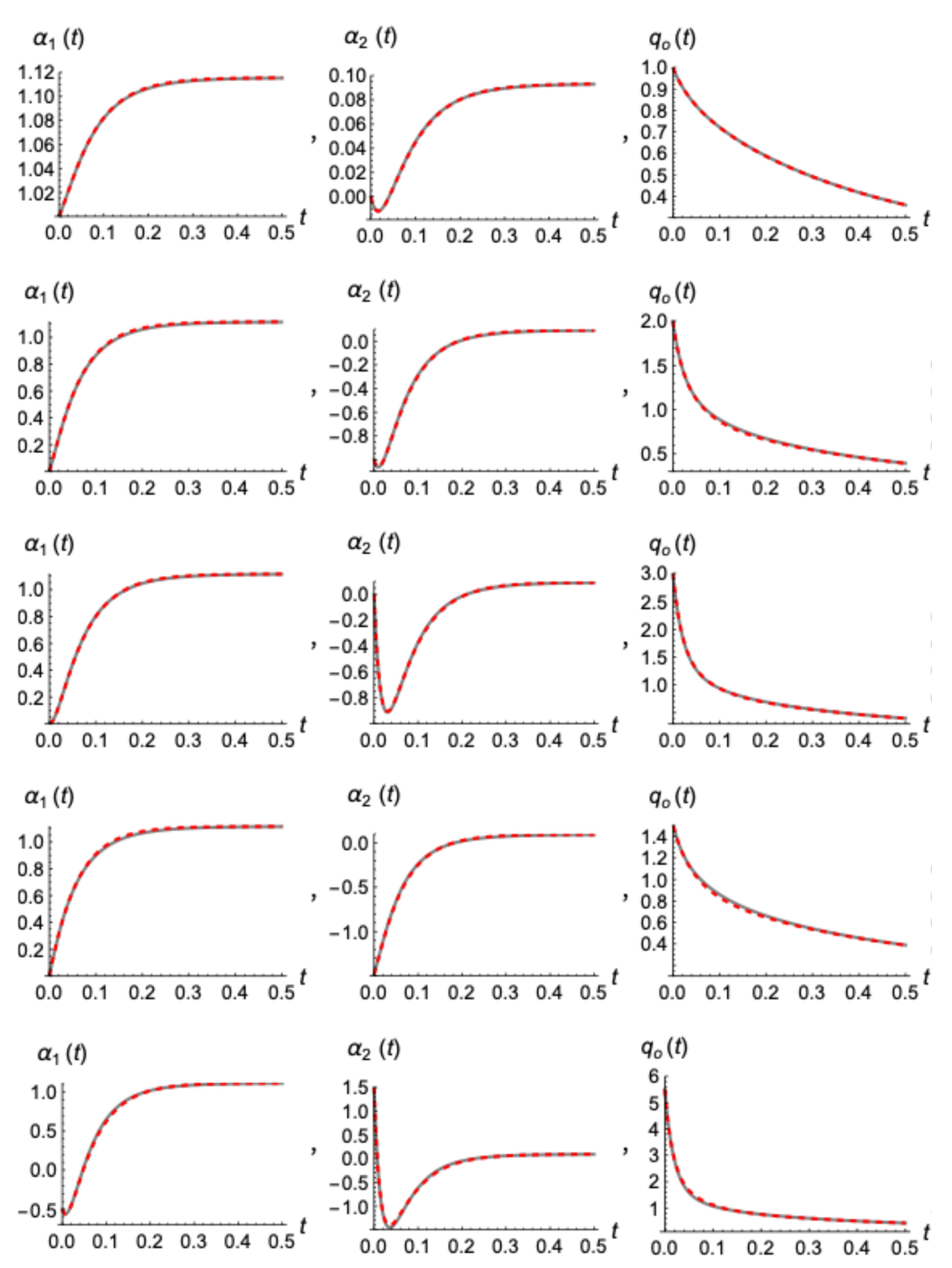Capitalizing on the previous Section 2.3, we constract in the following a model for the accurate derivation of the evolution of parameter . As we explained in detail, having means determining the evolution of both the water table head and the shape of the profile , in an accuracy that depends on how many terms are used. To our knowledge there is no other work emphasizing on the evolution of making our findings quite novel. The model offers new insight in describing and understanding the water table modifications during drainage and can serve as an efficient modelling tool.
In the direction of the previous analysis, we use the expansion presented in Equations (20)–(22) expressing the water profile as
keeping as many terms as we need, up to the desired order
, thus approximating
as
to conform all boundary conditions (23). To satisfy mass conservation, we introduce (43) into the mass balance Equation (17),
, deriving
where
, is the shape storage factor
and is a function of the model’s parameters
. Noting also, that the slope of the squared shape function
by Equation (44) at
x = 1 is
and using the result of Equation (26)
the mass conservation Equation (45) yields
which is the core of the present model’s formulation. Note that although in (49) we omitted writing explicitly the time dependence, the reader should still consider that all parameters are functions of time,
The Equation (49) forms a close system together with the relations for the evolution of
coming out by the (2
i-2)-order derivative versus
x of
Boussinesq Equation (25) through Equation (29), as analyzed in the previous section. This system constitutes the main modelling idea of this work and will be used extensivelly in the following.
Thus, the profile takes a constant shape, depends solely on
. The finite value of
, becomes then a function of the order
ν of the model Equation (49). In other words, it depends on the number of the terms that are used in the expansion (44), by solving the steady form of the mass balance Equation (49) which is expressed through
where, any time dependence has been removed. The gradual approach of
to its exact value given by eq. (36) as the order
ν of the model (49) increases, is shown in
Figure 3.
3.1. Analysis and Application of the New Model
Seeking for the best combination between accuracy and lack of complexity, we present a full analysis approximating the expansion (44) to the 6th order of x. In fact, the same analysis can be undertaken using an approximation of the 8th order (the upper end of the meaningful model’s choices, in our opinion) in a similar manner, but the difficulty which is added while improving accuracy obscures the clarity of the presentation.
Specifically, by setting
ν = 3, in Equation (44), we select a 6th in terms of
x, expansion of the profile shape of the form
Correspondingly, Equation (48) for the evolution of
becomes
In Equation (53), the storage
must be calculated numerically through the integral
while the partial derivatives
and
are calculated respectively through
and
Equation (53) forms a close system, in the context we presented, together with Equations (48) for , and (27) for .
Before proceeding with the numerical solution of the defined system of Equations, we will give a closer look at the late time behavior of this model. As the time derivatives vanish, the specific system of Equations drives
to a finite value (
Figure 3), which can be found by solving Equation (49). With our setting
ν = 3, this corresponds to solving
resulting to
. Then,
0.10447 and the finite shape function
s(
x) corresponds to a finite storage factor which is calculated (numerically) through (54) equal to
Thus, the slope of the squared shape function (42) becomes
. These results are close but surely not identical to the exact asymptotic values given in Equations (35), (36) and (41) from the exact solution of the Boussinesq Equation.
We may refine the above values by slightly modifying the exact Equation (27) introducing a parameter
as
This modification drives
to a finite value of
Although affecting the exact character of Equation (27), we should keep in mind that the whole procedure we describe is an approximate solution, which we try making as accurate as possible. Using (58) instead of (27) gives the advantage of tuning the finite behavior of the solution towards more accurate values. Furthermore, this modification does not affect seriously the observed accuracy of the model at early times, where other type of problems should be handled as it will be shown.
By using
as tuning parameter, we may seek the choice resulting to the most accurate finite state through Equation (57) which now reads
More specifically we seek the value of producing as accurate as possible finite values for , , as well as for the slope of the squared profile. We have concluded that the best choice is Using this value, we calculate, and the slope of the squared shape showing agreement up to the 4th decimal, when compared to the respective exact results of the Boussinesq Equation.
At this point, we must note that in the case of an 8th order expansion model (
ν = 4) the added degree of freedom will guarantee exact match of all three previous profile features,
,
, and correspondingly
by modifying properly the extra Equation (28) for
, to close the model, with the inclusion of another one tuning parameter
through
In that case the finite value of
is,
, and the finite value for
comes through solving the analog of Equation (60) for the next higher order,
finding the pair of (
,
) corresponding to the exact
Boussinesq values for
and
.
In
Figure 4, we present the finite profile shape of the introduced 6th order model
and the late time exact Boussinesq solution by Equation (35). The coincidence between the two profiles is remarkable. In fact, their difference, at its most, does not exceed 1%
0. Also, in
Figure 5,
Figure 6 and
Figure 7 we present the numerical solution of the full system of the model’s Equations (53,48,58) for the evolution of the profile during drainage, where three different initializations were used to test the model’s efficiency.
Specifically, in
Figure 5 the case starts with steady state after uniform recharging; thus, the initial profile is
. The presented results refer to the evolutions of parameter
, water table head,
, water table
and outflow
. As it is shown, the resemblance of the model’s solution to the exact numerical solution of the
Boussinesq Equation (11) is quite impressive. Even regarding the outflow, the most difficult parameter to capture accurately, since it is affected by the whole water profile’s development, the coincidence is very good. Besides a relative difference at very early times that will be discussed next, the model performs very accurately.
In
Figure 6 and
Figure 7, similar results are presented, for initial water tables of the forms
and
respectively. The comparison remains adequately good and in favor of the presented model (49).
Taking a closer look, however, at the behavior of the outflow at very early times (
Figure 8), we realize that there is some discrepancy which increases as the initial outflow (thus the slope of the shape of the squared profile) becomes bigger.
This deviation can be attributed to the fact that the presented sharp initial water tables aiming to emulate the end of a recharging period, impose different physical
characteristics compared to drainage profiles since they are not a solution of the same Equation. Specifically, Boussinesq Equation (11) during pure drainage, with a zero-water depth (constant in the more general case) at the end of the aquifer, at
x = 1, implies that the second derivative of the squared water profile versus
x vanishes. This is not the case during recharge periods as well as in none of the previously presented examples. To conform then the imposed initial profile, Boussinesq concludes with a “violent” modification, resulting into a sudden change of outflow at an infinite rate as it will be shown. Multiplying
Boussinesq Equation (11), during drainage, by
h(
x,
t) and differentiating versus
x, yields
Taking the limit of Equation (64) at
x = 1 and substituting
by Equation (19), we see that the time derivative of the outflow
equals
From Equation (65) becomes evident that, since the slope of the water profile at
x = 1 is infinite, in order of
to be definite the second derivative of the squared profile must be zero. Otherwise
is also infinite. Such a behavior is, strictly speaking, over the capabilities of the presented model, and demands different approximations to evolve up to a point that the model can accurately handle. Such a case is presented in
Figure 9, for an initial squared profile with zero second derivative at
x=1, slightly different than the one presented in
Figure 5. In this case the coincidence between the present model and the Boussinesq solution is almost perfect.
Modeling the very early time drainage and matching with the present model later on, is the subject of the following section.
3.3. An Analytic Explicit Linear Approximation for the Solution of the New Model
In this last section, we approximate the non-linear system of Equations (53), (58) and (48) of the previously introduced and analyzed model with a linear form alowing for an analytical explicit solution for and the rest of the parameters, which proves to be accurate and well understandable.
Substituting into the mass balance main Equation (53)
, of the model that was presented,
/12 by Equation (58) and its first derivative
, by
we conclude with
Then, dividing (79) with the multiplier of the term
,
, the mass balance Equation equivalently reads
which obviously is a second order non-linear differential Equation of
of the form
When time derivatives vanish, Equations (79-81) yield
which is exactly the late time solution by Equation (60), defining the finite value of parameter
,
. Noting that in Equation (81) the function
does not vary strongly (i.e., the denominator typically varies in a range between 2.6 and 2.9 for most cases) we may nicely approximate
in Equation (81) with its finite value
,
assuring that
reaches the correct finite state
In a rather crude way then, we simplify (83) even more, to the linear form
where the time dependent non-linear terms
and
have been approximated with the constants
A,
B. Equation (84) is the linear approxiamtion of the exact Equation (80).
We saw, quite intuitevelly, that the best choice for the linerization constant values comes through demanding Equation (84) to satisfy the exact initial values of
,
, and its derivatives at time zero,
, as they are defined by the exact setting up. That way, Equation (84) incorporates correctly the initial and the finite behavior of the original non-linear system. Specifically, we demand
A and
B to satsisfy the system
and by solving, we conclude with the desirable values
Noting that
and
are possitive and that they differ by two orders of magnitude, the solution of (84) is always meaningful and can be straight forward expressed into the form
with
and
to be given by
and
,
by
After that The integration of Equation (87) over time gives through Equation (23) the evolution of the water table head at
x = 0,
, in the form
The remaining parameter is calculated also by Equation (58) as /12. With these parameters we have completed the analytic approximation for the solution of the model and we may procced with the testing of its performance.
In the last
Figure 15, we present the comparison between the evolutions of
,
and outflow,
as they are calculated numerically from the exact presented model in section 3.1, and analtically by its explicit linear approximation (89-90). We used all the previous initializations they have been discussed so far, corresponding to an initial
equal to,
,
,
and
. We have also added a more “exotic”, non-monotonous initial profile equal to
. As it is shown, the performnce of the analytical expression (89) in estimating
is overall very good with an accuracy of the order of 5 %
0 at its worst. This leads also to the accurate calculation of the rest of the parameters and especially the outflow, the most dificult one, to an accuracy of the order of ±1% at the worst case. That way, expressions (89) and (90) may serve as an easy and accurate representation both for the investigation and understanding of the drainage flow, as well as a modelling basis for handling more real cases.
Concluding, we should note that the same linearization idea can be applied in the case of a more accurate and detailed model of 8th order, by calculating three linearization parameters in that case
which yields a solution for
of the form
However, finding the proper linerization values for the constants A, B, C is much more complicated and needs special attention for satisfying stricter criteria for the solution to be well behaved.


















